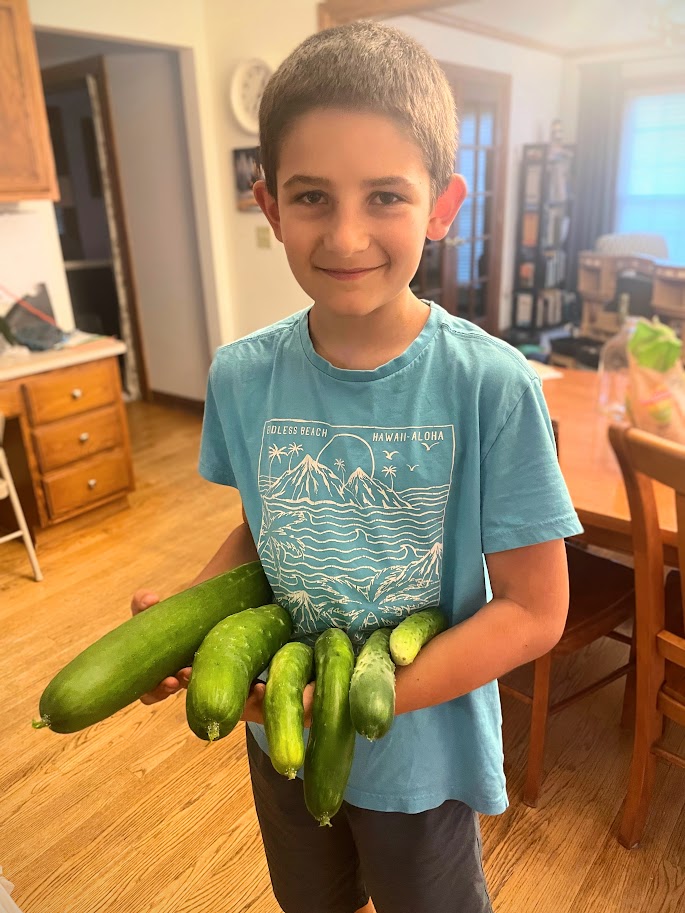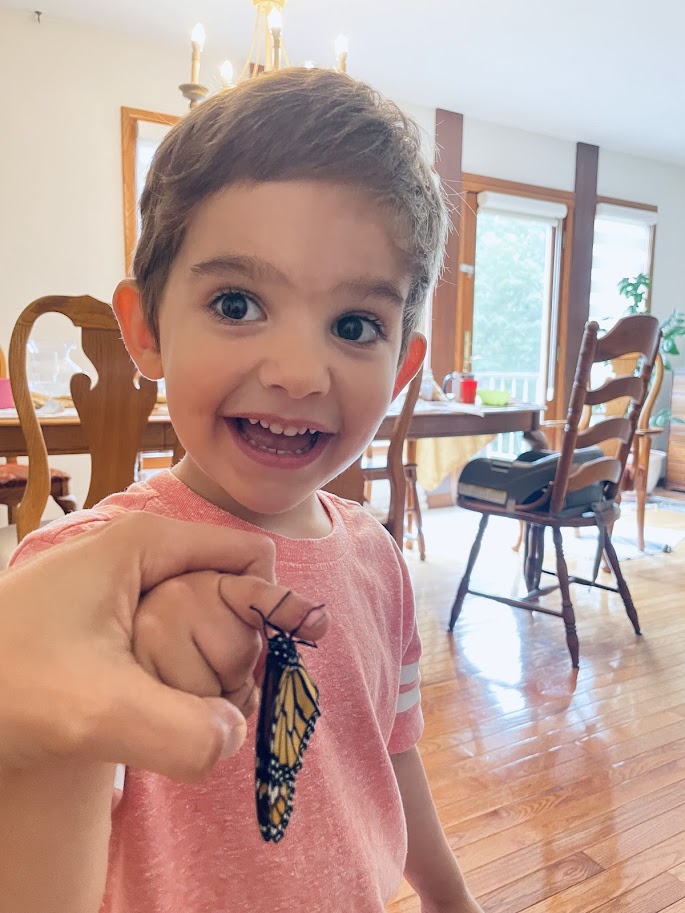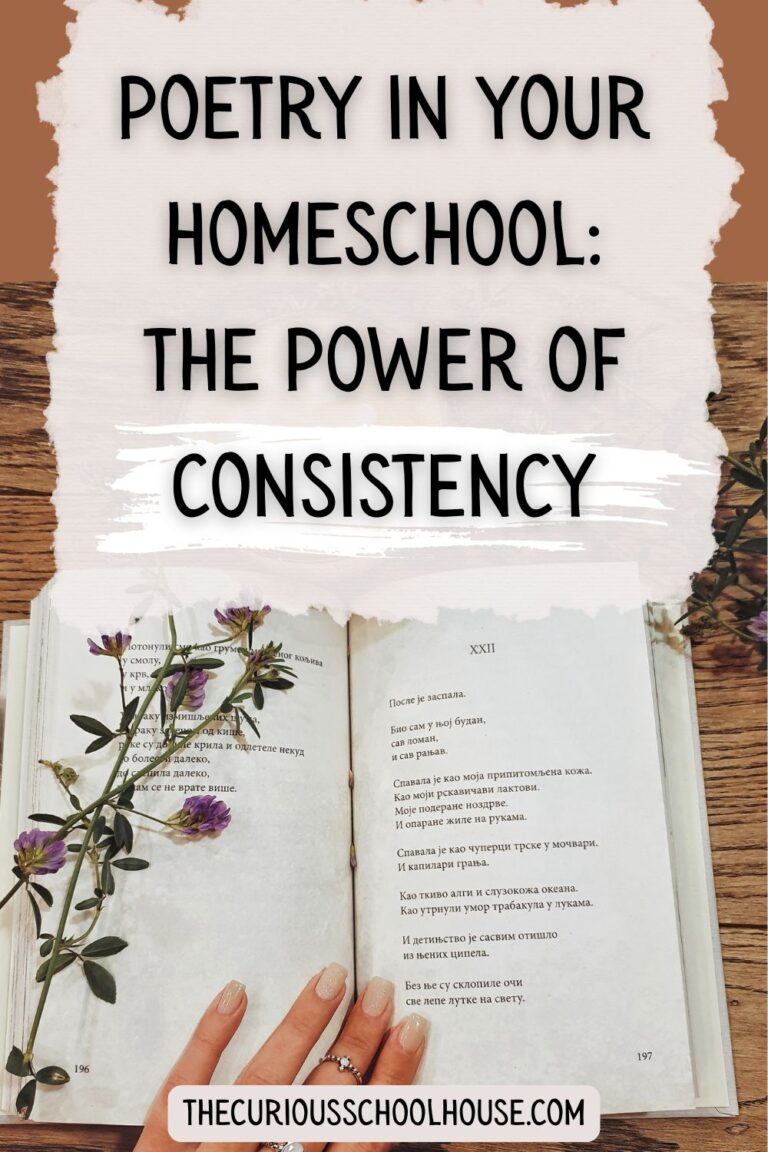Homeschool Morning Time Made Simple: Peaceful Mornings + Living Ideas
This post shares a simple guide to using homeschool morning time in your daily routine. We’ll discuss why morning time matters (and what it is), how to get started with morning time, and common challenges you might face.
A complicated homeschool will not survive.
The more children you have, the more true this is!
I’ve written already about our simple, minimalist homeschool approach – the reason for this being that, if I want to survive all TWENTY-ONE YEARS of homeschooling my children (from kindergarten of our oldest to 12th grade of our youngest), I must keep things simple and sustainable.
In our quest to do just that, morning time has gradually become one of the foundational parts of our day – the part I look forward to most!
This is one of our main school time blocks, and our children get to share this experience all together. After all, one the biggest perks to homeschooling is the massive increase in family time: we have the potential for even stronger relationships with our children (and between siblings) simply because we are sharing so much of our lives together.
This family time together starts to diminish once the kids grow up a little, are capable of more independent work, and are sent off to work individually for most of the school day. I am not saying that this is a bad thing – independence is wonderful! – but I am saying that, in these times, it is even more important to intentionally carve out time where the whole family comes together.
I don’t know about you, but I did not choose homeschooling because I was hoping to avoid my children for the whole day!
Here then lies the conundrum: our children are growing in maturity and independence, and we want to empower them to learn and study on their own – yet at the same time, we see the years flying by and want to savor our time together as much as we still can.
Enter: morning time.

Why Morning Time Matters (and what it is)
The basic premise is very simple: you gather the whole family together, read something, and briefly talk about it together or have the children narrate. Some families might call it “morning circle” or “morning basket” – and it doesn’t even have to be done in the morning! You could do it in the afternoon, as a “wrap up the day” sort of activity, or even in the evening when Dad can participate too.
The wonderful thing about it is that you are knocking off a whole bunch of subjects from your list all at once, and you don’t have to spend individual time with every single child in order to do so!
Here are just a few more reasons why it has become one of the foundations of our homeschool day:
- It’s simple. I have a deep and abiding love for anything that is both simple AND effective. Morning Time is simple enough that we can continue on through sickness, changes in routines, times of financial hardship, and can even be done while nursing or rocking a baby.
- It’s efficient. The more things we can do with all our children at once, the more streamlined and efficient our day becomes. And no, our ultimate goal in homeschooling is NOT efficiency (remember that we are gardeners, not robots, and gardening is messy, unpredictable work) but at the same time we DO need some habits that will make this homeschooling gig more sustainable. The more solid habits and routines we have in place, the better we are able to continue, year after year. Morning Time is one of these habits.
- It starts our day with beauty and truth. What better way to start off your day than with some beautiful music, scripture, poetry, or literature? It feels like such a good, life-giving way to begin the school morning – by filling our hearts and souls with something worth thinking about.
- It builds relationships and fosters connection. Again, this is the joy of doing this as a whole family. We are slowly building up a shared history of stories and inside jokes, and this is a bond we will have forever! Reading aloud as a family brings us together, and I’m a big fan of anything that will create more connection within our family.
- It gives priority to what matters most. Too often, the big, test-worthy subjects are inadvertently given priority in our homeschools. We all know that in order to pass a test and be accepted to college, our kids will probably need to understand math, be able to write coherent paragraph, and use a computer. But where do Bible stories fit in to this equation? How do I fit in something I know is worthy – like poetry, or art – but that will never come up on a standardized test? Morning time is the answer.
What You Can Include in Morning Time
Pro tip: do not, I repeat, DO NOT try to do everything on this list. These are simply options to choose from. For us in this season I find that 4-5 options is a good number to have on hand, and we generally read from three or four of them on any given day.
- Bible readings or Bible stories
- Devotionals
- Hymns and folk songs
- Poetry
- Picture study
- Composer study
- Literature or chapter book read alouds
- Memory work
- Nature journaling
- Shakespeare
- History readings
- Science readings
- Fairy tales
- Biographies
- Anything else that can be enjoyed by ALL ages!

How to Get Started With Homeschool Morning Time
Step 1: Gather the Books
Choose which items from the list above are most important to you at this particular time (or, look for which ones you already have on hand!) and decide where you and the children will gather for your morning time. If you need help finding good, living books in any of these genres, check out this post on how to find the best books for homeschooling.
Remember: as excited and ambitious as you might feel, don’t try to do too many, especially if this is your first attempt at morning time! Keep in mind your children’s ages and stages.
Finally, as you are gathering the books, think also about gathering some things your children can do with their hands – especially if they are under the age of 10. More on that later!
Step 2: Gather the Children
I don’t think babies need to be involved (unless you really want them to), but starting around age 3 our children have generally been able to play quietly in the same room while I read. No, they’re probably not getting anything out of the books I’m reading, but they are “participating” with us – which they usually love much more than being banished to another room – and they are also learning how to amuse themselves quietly. This is a necessary skill!
With children younger than three, I would usually try to either time our Morning Time to coincide with a morning nap, OR we would do it during the baby’s independent playtime. If you’ve never tried independent playtime with a baby, RUN over to that post and check it out. Your life is about to become so much better.
Step 3: (you) Read and (they) Talk
Now that you have the books and the children (and the baby is playing happily in their room), it’s time to read! Start with short sections if this is new to you all – perhaps one chapter, or even a half a chapter. After you read, ask the children what they heard, and listen to their answers. Don’t re-read if someone wasn’t listening – it’s a shame that they missed out, but hopefully they will pay attention better the next time. Knowing they will have a second chance to listen to the material disincentives the children to listen the first time.
Don’t be discouraged by short answers (or no answers). Consistency works wonders, and narrations (the telling back) will get better with time. Consider modeling a narration or two for the children yourself, so they understand what sort of “telling back” you are looking for.
It’s also best if we mothers do NOT talk too much, explain, lecture, or pontificate. Yes, we can give little clarifications or answers to questions the children have (if necessary), but in general, the more explaining we do about the reading, the less thinking and connecting the children will do for themselves.
It’s okay to leave some questions unanswered in the child’s mind – they’ll come to the answer in time, and then when they do it will be truly theirs. Charlotte Mason said that “the only true education is self- education,” so we must avoid the common trap of doing all the thinking and questioning for our children.
Extra Tips
Here are a few more tips we have learned from our experience with Morning Time:
1. If you and your children are NOT enjoying something you are reading, feel free to change it! There’s no rule that says just because you started a book you must finish it to the bitter end. Yes, give it a fair chance, and yes, some books take a little time to draw you in, but if you’re halfway through and dreading picking it up every day, you’ll be better off putting it away and trying something new. Everyone has occasional off days, but most of the time, Morning Time should be an enjoyable experience for all of you.
2. Most kids listen better when their hands are busy (especially under the age of 10). It may take some trial and error to figure out which activities are too distracting and which ones help them focus, but don’t be afraid to let them color or play with something while you read. Noisy toys are not good, and neither is anything that takes too much concentration. Consider handing out coloring books, or blocks, or playdough while you read – and see how it goes.
3. If you’re not sure if they are listening or not, ask them to narrate! Let them tell you what they heard, and then you’ll know how it’s going. Narrations can also take the form of drawings about what they heard, building a scene out of Legos, or acting out something from the story. Be creative and look for ways your children can express their understanding.
4. Start small. We began several years ago by reading just two different books, and only a short bit from each. You can slowly increase the length over time as your children grow and get used to the idea! Now we usually read from four different books and it takes about an hour all together.

Common Challenges to Homeschool Morning Time and What to Do About It
Challenge 1: Short attention spans (“oh, look! squirrel!”).
Please note that I am talking about everyone here, including you! From the 2-year-old all the way up to the 39-year-old, if we are not used to listening and paying attention, this will be difficult. Listening carefully, paying attention, and then telling someone what you heard is not an easy thing to do.
If you try this yourself, along with your children, you’ll quickly see what I mean. In fact, that’s a great way to begin, if you’ve never done narration before: read something, and then narrate it yourself to the children! Let them see what you mean by the idea, and even let them see you struggle – so they know that they, too, can learn to do new hard things.
What to do about it: Be consistent, but start small. Start with a small section of your book – maybe even just one paragraph. Read it, close the book, and ask, “What did you hear?” If no one knows what to say, then set the example and give your own (hopefully brief) narration of what you remember.
Do this again tomorrow, and again the next day. Consistency does wonders for our homeschools! Once your kids can regularly and easily tell you what they heard from one paragraph, try a little longer section. Rinse and repeat.
Challenge 2: Distractions and (“no, you can’t have a snack!”)… Interruptions.
Oooh this is a hard one. Even still, after years and years of reading aloud to children every single day, I am still interrupted on a regular basis. Thankfully, it’s gotten better over the years, and *most* of the interruptions now come from the toddler – which is to be expected.
However, I still can’t seem to help getting frustrated when we’re in the middle of a climactic scene in our story and someone interrupts to ask for a drink of water. Internally I am screaming, “Seriously? Can’t you wait until Frodo makes it up the side of Mount Doom??” even though I might be grimacing smiling serenely on the outside.
What to do about it: Keep going, and pray for patience. I don’t have any great “hacks” for this issue (if you do, please share in the comments!), but I can give you encouragement that it gets better as the children age. Most days, I don’t get unrelated interruptions from the older children anymore. Praise! The younger two (3 and 6) are still working on understanding this idea.
And again – sorry to beat a dead horse here – the more you do Morning Time, the more chances your children will have to practice. Consistency works wonders.
I’ve thought at times about starting a system like “everyone gets ONE ticket to use to interrupt me, and after that you can’t do it again or I’m burning the book until I finish the chapter” but never actually ended up trying it. Instead, we’ve done a lot of reminders (“Please don’t interrupt me when I’m reading unless it’s a question ABOUT THE STORY. No, telling me your dream from last night is NOT a question about the story. Neither is your 439th request for a snack.”) and I have learned a lot of patience. More still to learn!
Challenge 3: Feeling pressure to “do it all” or to finish the book.
Here is something I heard recently that resonated deeply with me (I believe the excellent Read Aloud Revival podcast was where I first heard it):
We need to remember that the true learning, the magic of homeschooling, happens in the doing, not the finishing.
It is the reading of Shakespeare that ignites our imagination and expands our vocabulary, not the finishing of a certain number of plays. It is the doing of math that teaches our children how numbers work and the beauty of logic, not the finishing of the math book.
Of course, the doing of the math and the reading of the play will eventually lead to finishing a number of plays and finishing the math book, but if I can remember that the finishing is not the end goal, it helps me immensely to slow down, relax, and savor the doing – and isn’t that what we truly want in our homeschool?
Do I want to rush through everything in my day in an attempt to “finish,” “stay on schedule,” or “check all the boxes”? Or would I rather slow down, have more peace in my day, and truly enjoy the moments we have together?
I can tell you I would absolutely, unequivocally, choose the latter.
What to do about it: Remember that finishing does not equal learning. Your children might learn more, and better, if you read more slowly, or if you take more time on the math lesson.
Even if you are a planner by nature, resist the urge to plan too much. Don’t write down how far you plan to get in every book every day, because this level of detail will put pressure on you to finish what you have planned.
On the opposite end, if you are someone who never plans and struggles to finish anything – well, you probably aren’t having trouble with feeling the pressure to do it all. In your case, remember that consistency works wonders. It might feel stifling for certain personalities, but it’s truly where the magic happens.

Conclusion
If you are like me, you probably don’t enjoy the feeling of someone telling you, “Here’s ANOTHER thing you really SHOULD be doing – now let’s see if we can squeeze it into your already-busy-homeschool day!”
However, to me, Morning Time feels like the opposite. It feels like someone is saying, “Stop trying to do a separate science curriculum with each child – just pick one book and read it to all of them. Stop buying those fancy ‘literature’ textbooks and workbooks – just choose a classic book and read it to all your children. Your homeschool can be simpler – and your kids will learn even more.”
Instead of continually doing more and more, we are doing less – but doing it well.
Instead of sending our kids off to the four corners of the earth our house with their individual work for the entire day, we bring them together and learn as a family.
Instead of prioritizing the subjects that will get them into college, we begin our day with the subjects that will touch their hearts.
“What is morning time? It is capturing the hours of your day before they flit away. It is making sure the most beautiful things happen first. It is impossible to regret that.“ ~ from Morning Time: a Liturgy of Love by Cindy Rollins







